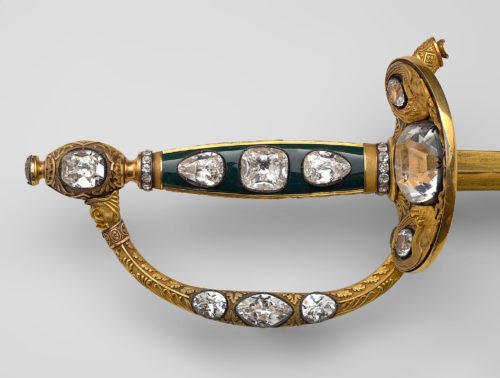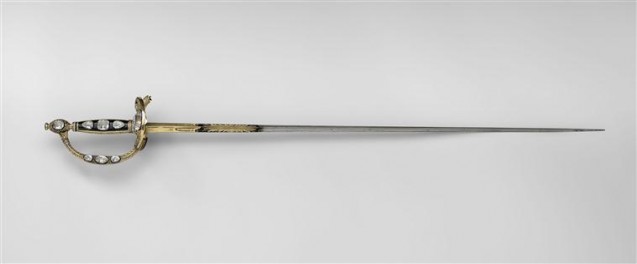When Napoleon became First Consul, he managed to buy the Regent back on 3 Ventôse An IX (22 February 1801) from Joseph-Ignace Vanlerberghe, the banker and supplier to the French army who had received it as a security from the Directory, thereby rendering possible its addition to his new ceremonial weapon. The Moniteur universel of 20 Brumaire Year X (12 November 1801) noted that “The diamond, known as The Regent, which, during the Revolution, was used as a security, has been redeemed by the government. The depositors were threatening to sell it at a very low price, if the funds they had advanced were not returned to them. The diamond, the most beautiful in existence, was deemed worthy of being placed on the hilt of the sword which is the distinctive mark of First Consuls. It is true that, because of their opulence and decorative beauty, diamonds are really only suitable for women; but the Regent, because of its size, beauty and rarity, is an exception to this rule“.
Though a sabre was originally planned, it was to be a ceremonial épée or small sword that was made, the blade of which was ordered from the famous Versailles arms factory run by Nicolas-Noël Boutet. The gems were set by the jeweller Marie-Etienne Nitot, whilst the handle and the gold fittings of the tortoiseshell scabbard were entrusted to the goldsmith Jean-Baptiste-Claude Odiot. On the latter, Odiot depicted the Caduceus of Commerce, the Mirror of Prudence, and the Laurels of Victory. The sword was studded with forty-two brilliant cut diamonds, in total 254 carats 21/64, the centrepiece of which was obviously the Regent placed in the guard, which was valued at the enormous sum of six million francs for 136 carats 7/8. The report drawn up in 1812 on the dismantling of the diamonds, mentions the other gems, some of which were the result of revolutionary confiscations from emigrants.

The sword must have been completed in an extremely short time, for the Moniteur reports that he wore it during the celebrations marking the second anniversary of his accession to power, in November 1801. He displayed it again at the official proclamation of the Concordat held at the Cathedral of Nôtre-Dame de Paris and then at the Tuileries on Easter Sunday, 28 Germinal Year X (18 April 1802), and most importantly at the coronation and consecration ceremony [Sacre] on 11 Frimaire Year XIII (2 December 1804): indeed it can be seen perfectly on Jean-Baptiste Isabey’s drawing of the Emperor in his “undress” robes (Livre du Sacre, planche du petit habillement de l’Empereur).
Quite naturally it was carefully maintained. The Emperor’s First Chamberlain, Auguste-Laurent de Rémusat, paid an invoice of 84 francs to the silversmith Martin-Guillaume Biennais on 17 October 1807 for “repairing the handle of the sword on which the Regent is set, dismantling it to polish it and reassembling it”. The sword appears in paintings of the First Consul by artists such as Jean-Dominique Ingres (Liège, la Boverie), Antoine-Jean Gros (Paris, Musée de la Légion d’Honneur), Charles Meynier (Brussels town hall), Joseph-Marie Vien le jeune (Bruges town hall). It even appears in later portraits of the Emperor in his coronation costume, such as the famous painting by François Gérard, of which many copies were made, or the one by Robert Lefèvre showing him in the uniform of a colonel of the grenadiers of the guard, dated 1806 (Musée National du Château de Versailles).
In 1811, Napoleon decided to replace this sword with a new one ordered from Marie-Etienne Nitot’s son, François-Régnault Nitot, who had take over from his father on the latter’s death in 1809. The stones on the coronation sword, including the Regent, were de-mounted and re-used for this new sword; simple cut crystals were set on the old one in their place. Napoleon offered this latter sword, which as a result had no real value, to Nitot fils. It was Lieutenant-Colonel Edgar Nitot who gave it to Prince Victor Napoleon in 1905. The French state acquired it from the Victor’s son, Prince Louis Napoleon, in 1979, and it is currently held at the Napoleon I Museum at the Château de Fontainebleau.
Bernard Chevallier
April 2021 (translation RY, PH)
Bernard Chevallier is General Curator of Heritage and former Director of the French National Museum of the Châteaux of Malmaison and Bois-Préau; he is co-curator of the Napoléon exhibition presented from 28 May to 19 December 2021 at the Grande Halle of La Villette, where the coronation sword [Sacre] is featured.
Discover another object from the exhibition: Napoleon’s famous grey Greatcoat.


